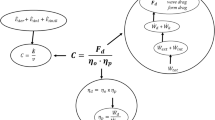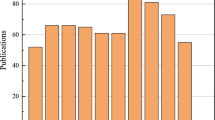Summary
From measurements of gas exchange of single tethered bees flying in a closed-circuit miniature respiration wind tunnel atRQ=1.0, a relative metabolic power (relative metabolic rate) ofP mrel=0.515±0.1W g−1 was calculated based on a body mass of 80 mg for an ‘empty’ bee. This did not vary significantly over the temperature range 25.3°C≤T a≤34.0°C, but was significantly lower atT a=20°C. Over the range 22°C≤T a≤26°CP mrel was 0.379±0.07 W g−1.
Relative metabolic powerP m rel was calculated from round-about or wind tunnel post-flight thorax cooling rates (exponentially rising from 1 to 5.5°C min−1 per °C temperature difference at wind velocities from 0 to 4.3 m s−1) and from differences between thorax surface temperature and ambient temperature (exponentially decreasing from 6 to 1°C over the same range of wind velocities). A value ofP mrel=0.195±0.09W g−1 was found, independent of wind velocity.
From measurements of exhaustion flights of defined fed bees executing prolonged flights (30.6±4.7 min) in front of an open-jet wind tunnel, a relative metabolic power of 0.309±0.05 W g−1 was calculated, which did not vary significantly over the temperature range 25°C≤T a≤35°C, but was significantly lower atT a=20°C.
Our data from 3 experimentally different determinations ofP mrel are compared to data from a number of literature sources. A critical discussion suggests probable values of approximately 0.3 W g−1 for tethered flights (round-abouts, wind-tunnels), 0.4 W g−1 for medium speed free-foraging flights, and 0.5 W g−1 for hovering flight. Probable mechanical flight power for a muscle efficiency of 0.2 in medium speed free-foraging flight is approximately 70 mW g−1 body mass (equivalent to 5.6 mW for an ‘empty’ 80 mg bee) and 230 mW g−1 flight muscle mass. This is in the upper range of theoretical calculations, but not excessively high.
Similar content being viewed by others
References
Bastian J, Esch H (1970) The nervous control of the indirect flight muscles of the honey bee. Z Vergl Physiol 67:307–324
Berg S (1988) Größenabhängige Flugdauer beim Paarungsflug der Drohne (Apis mellifera). In: Nachtigall W (ed) BIONA report 7. Publ Acad Wiss Lt Mainz Fischer, Stuttgart, New York, pp 43–50
Berger M (1974) Oxygen consumption and power of hovering hummingbirds at varying barometric and oxygen pressures. Naturewissenschaften 61:407
Beutler R (1937) Über den Blutzucker der Bienen. Z Vergl Physiol 24:71–115
Casey TM (1976) Flight energetics of sphinx moth: Power input during hovering flight. J Exp Biol 64:529–543
Chappell M (1984) Thermoregulation of the green fig beetle (Cotinus texana) during flight and foraging behavior. Physiol Zool 57:581–539
Church NS (1964) Heat loss and body temperature of flying insects. II. Heat conduction within the body and its loss by radiation and convection. J Exp Biol 37:186–212
Cooper PD, Schaffer WM (1985) Temperature regulation of honey bees (Apis mellifica) foraging in the sonoran desert. J Exp Biol 114:1–15
Crailsheim K (1988) Intestinal transport of glucose solution during honeybee flight. In: Nachtigall W (ed) BIONA report 7. Publ Acad Wiss Lit Mainz, Fischer, Stuttgart, New York, pp 119–128
Ellington CP (1984) The aerodynamics of hovering insect flight. Phil Trans R Soc London B 306:1–181
Ellington CP (1985) Power and efficiency of insect flight muscles. J Exp Biol 115:293–304
Esch H (1976) Body temperature and flight performance of honey bees in a servomechanically controlled wind tunnel. J Comp Physiol 109:265–277
Feller P (1985) Windkanalflug von Honigbienen (Apis mellifica carnica): Untersuchungen zu Treibstoffverbrauch, Flugphysiologie und Thermoregulation. Diplomarbeit, Universität Saarbrücken, unpublished
Feller P, Nachtigall W (1989) Flight of the honey bee. II. Innerand surface thorax temperatures and energetic criteria, correlated to flight parameters. J Comp Physiol B 158:719–727
Heath JE, Josephson RK (1970) Body temperature and singing in the singing katydid,Neoconocephalus robustus (Orthoptera, Tettigoniidae). Biol Bull 138:272–285
Heinrich B (1979) Keeping a cool head: honeybee thermoregulation. Science 205:1269–1271
Heinrich B (1980) Mechanisms of body-temperature regulation in honeybees,Apis mellifera. II. Regulation of thoracic temperature at high air temperatures. J Exp Biol 85:73–87
Hocking B (1953) The intrinsic range and speed of flight of insects. Trans R Entomol Soc Lond 104:223–345
Jongbloed J, Wiersma CAG (1934) Der Stoffwechsel der Honigbiene während des Fliegens. Z Vergl Physiol 21:519–533
Jungmann R (1984) Stoffwechselphysiologische Untersuchungen an in einem Miniaturwindkanal fliegenden Honigbienen (Apis mellifica). Diplomarbeit, Universität des Saarlandes, unpublished
Jungmann R, Rothe U, Feller P, Nachtigall W (1989) Flight of the honey bee. I. Thorax surface temperature and thermoregulation during flight. J Comp Physiol B 158:711–718
Kosmin NP, Alpatow WW, Resnitschenko MS (1932) Zur Kenntnis des Gaswechsels und des Energieverbrauchs bei der Biene in Beziehung zu deren Aktivität. Z Vergl Physiol 17:408–422
Levebre ZA, Hoover RE (1970) Solubilization, purification and some properties of trehalase from honeybee (Apis mellifera). Arch Biochem Biophys 140:514–518
Lindauer M (1954) Temperaturregulation und Wasserhaushalt im Bienenstaat. Z Vergl Physiol 36:391–432
Nachtigall W (1966) Die Kinematik der Schlagflügelbewegungen von Dipteren. Methodische und analytische Grundlagen zur Biophysik des Insektenflugs. Z Vergl Physiol 52:155–211
Nicolson SW, Louw GN (1982) Simultaneous measurement of evaporative water loss, oxygen consumption, and thoracic temperature during flight in a carpenter bee. J Exp Zool 222:287–296
Parhon M (1909) Les échanges nutritifs chez les abeilles pendant les quatres saisons. Ann Soc Nat Zool 9:1–50
Rothe U (1983) Stoffwechselphysiologische Untersuchungen an ruhenden, laufenden und fliegenden Honigbienen (Apis mellifica carnica). Dissertation, Universität des Saarlandes, unpublished
Rothe U, Nachtigall W (1980) Zur Haltung vonApis mellifica in einem Flugraum. Apidologie 11:17–24
Rothe U, Nachtigall W (1982) Erfahrungen mit einem Bienenflugraum. Spontane Königinnenaufzucht und Lebensdaueranalysen. Apidologie 13:241–246
Rothe U, Nachtigall W (1989) Flight of the honey bee. IV. Respiratory quotients and metabolic rates during sitting, walking and flying. J Comp Physiol B 158:739–749
Scholze E, Pichler H, Heran H (1964) Zur Entfernungsschätzung der Bienen nach dem Kraftaufwand. Naturwissenschaften 3:69–70
Soltavalta O (1954) On the fuel consumption of the honey-bee (Apis mellifica L.) in flight experiments. Ann Zool “Vanamo” 16:1–27
Tauchert F (1930) Weitere Stoffwechseluntersuchungen an Insekten. Z Biol 89:541–546
Weis-Fogh T (1972) Energetics of hovering flight in hummingbirds and in Drosophila. J Exp Biol 56:79–104
Weis-Fogh T, Alexander McN (1977) The sustanined power output obtainable from striated muscle. In: Pedley TJ (ed) Scale effects in animal locomotion. Academic Press, London New York, pp 511–526
Wieser W (1986) Bioenergetik. Energietransformation beim Organismus. Thieme, Stuttgart New York
Wille R (1963) Beiträge zur Phänomenologie der Freistrahlen. Z Flugwiss 11
Withers PC (1981) The effect of ambient air pressure on oxygen consumption of resting and hovering honeybees. J Comp Physiol 141:433–437
Author information
Authors and Affiliations
Rights and permissions
About this article
Cite this article
Nachtigall, W., Rothe, U., Feller, P. et al. Flight of the honey bee. J Comp Physiol B 158, 729–737 (1989). https://doi.org/10.1007/BF00693011
Accepted:
Issue Date:
DOI: https://doi.org/10.1007/BF00693011




